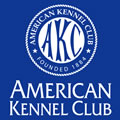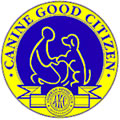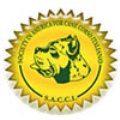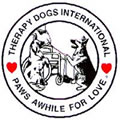AKC Rottweiler Breed
Standard
General
Appearance
The ideal Rottweiler is a medium large, robust and powerful dog, black with
clearly defined rust markings. His compact and substantial build denotes great strength, agility and endurance.
Dogs are characteristically more massive throughout with larger frame and heavier bone than bitches. Bitches
are distinctly feminine, but without weakness of substance or structure.
Size, Proportion, Substance
Dogs--24 inches to 27 inches. Bitches--22 inches to 25 inches, with preferred
size being mid-range of each sex. Correct proportion is of primary importance, as long as size is within the
standard's range.
The length of body, from prosternum to the rearmost projection of the rump, is
slightly longer than the height of the dog at the withers, the most desirable proportion of the height to
length being 9 to 10. The Rottweiler is neither coarse nor shelly. Depth of chest is approximately fifty
percent (50%) of the height of the dog. His bone and muscle mass must be sufficient to balance his frame,
giving a compact and very powerful appearance.
Serious Faults--Lack of proportion, undersized, oversized, reversal of sex
characteristics (bitchy dogs, doggy bitches).
Head
Of medium length, broad between the ears; forehead line seen in profile is
moderately arched; zygomatic arch and stop well developed with strong broad upper and lower jaws. The desired
ratio of backskull to muzzle is 3 to 2. Forehead is preferred dry, however some wrinkling may occur when dog is
alert. Expression is noble, alert, and self-assured. Eyes of medium size, almond shaped with well fitting lids,
moderately deep-set, neither protruding nor receding. The desired color is a uniform dark brown. Serious
Faults--Yellow (bird of prey) eyes, eyes of different color or size, hairless eye rim.
Disqualification--Entropion. Ectropion. Ears of medium size, pendant, triangular in shape; when carried alertly
the ears are level with the top of the skull and appear to broaden it. Ears are to be set well apart, hanging
forward with the inner edge lying tightly against the head and terminating at approximately mid-cheek. Serious
Faults--Improper carriage (creased, folded or held away from cheek/head). Muzzle--Bridge is straight, broad at
base with slight tapering towards tip. The end of the muzzle is broad with well developed chin. Nose is broad
rather than round and always black. Lips-Always black; corners closed; inner mouth pigment is preferred dark.
Serious Faults--Total lack of mouth pigment (pink mouth). Bite and Dentition--Teeth 42 in number (20 upper, 22
lower), strong, correctly placed, meeting in a scissors bite--lower incisors touching inside of upper incisors.
Serious Faults--Level bite; any missing tooth. Disqualifications--Overshot, undershot (when incisors do not
touch or mesh); wry mouth; two or more missing teeth.
Neck, Topline, Body
Neck--Powerful, well muscled, moderately long, slightly arched and without loose
skin. Topline--The back is firm and level, extending in a straight line from behind the withers to the croup.
The back remains horizontal to the ground while the dog is moving or standing. Body--The chest is roomy, broad
and deep, reaching to elbow, with well pronounced forechest and well sprung, oval ribs. Back is straight and
strong. Loin is short, deep and well muscled. Croup is broad, of medium length and only slightly sloping.
Underline of a mature Rottweiler has a slight tuck-up. Males must have two normal testicles properly descended
into the scrotum. Disqualification--Unilateral cryptorchid or cryptorchid males. Tail--Tail docked short, close
to body, leaving one or two tail vertebrae. The set of the tail is more important than length. Properly set, it
gives an impression of elongation of topline; carried slightly above horizontal when the dog is excited or
moving.
Forequarters
Shoulder blade is long and well laid back. Upper arm equal in length to shoulder
blade, set so elbows are well under body. Distance from withers to elbow and elbow to ground is equal. Legs are
strongly developed with straight, heavy bone, not set close together. Pasterns are strong, springy and almost
perpendicular to the ground. Feet are round, compact with well arched toes, turning neither in nor out. Pads
are thick and hard. Nails short, strong and black. Dewclaws may be removed.
Hindquarters
Angulation of hindquarters balances that of forequarters. Upper thigh is fairly
long, very broad and well muscled. Stifle joint is well turned. Lower thigh is long, broad and powerful, with
extensive muscling leading into a strong hock joint. Rear pasterns are nearly perpendicular to the ground.
Viewed from the rear, hind legs are straight, strong and wide enough apart to fit with a properly built body.
Feet are somewhat longer than the front feet, turning neither in nor out, equally compact with well arched
toes. Pads are thick and hard. Nails short, strong, and black. Dewclaws must be removed.
Coat
Outer coat is straight, coarse, dense, of medium length and lying flat. Undercoat
should be present on neck and thighs, but the amount is influenced by climatic conditions. Undercoat should not
show through outer coat. The coat is shortest on head, ears and legs, longest on breeching. The Rottweiler is
to be exhibited in the natural condition with no trimming. Fault--Wavy coat. Serious Faults--Open, excessively
short, or curly coat; total lack of undercoat; any trimming that alters the length of the natural coat.
Disqualification--Long coat.
Color
Always black with rust to mahogany markings. The demarcation between black and
rust is to be clearly defined. The markings should be located as follows: a spot over each eye; on cheeks; as a
strip around each side of muzzle, but not on the bridge of the nose; on throat; triangular mark on both sides
of prosternum;on forelegs from carpus downward to the toes; on inside of rear legs showing down the front of
the stifle and broadening out to front of rear legs from hock to toes, but not completely eliminating black
from rear of pasterns; un-der tail; black penciling on toes. The undercoat is gray, tan, or black. Quantity and
location of rust markings is important and should not exceed ten percent of body color. Serious
Faults--Straw-colored, excessive, insufficient or sooty markings; rust marking other than described above;
white marking any place on dog (a few rust or white hairs do not constitute a marking). Disqualifications--Any
base color other than black; absence of all markings.
Gait
The Rottweiler is a trotter. His movement should be balanced, harmonious, sure,
powerful and unhindered, with strong forereach and a powerful rear drive. The motion is effortless, efficient,
and ground-covering. Front and rear legs are thrown neither in nor out, as the imprint of hind feet should
touch that of forefeet. In a trot the forequarters and hindquarters are mutually coordinated while the back
remains level, firm and relatively motionless. As speed increases the legs will converge under body towards a
center line.
Temperament
The Rottweiler is basically a calm, confident and courageous dog with a
self-assured aloofness that does not lend itself to immediate and indiscriminate friendships. A Rottweiler is
self-confident and responds quietly and with a wait-and-see attitude to influences in his environment. He has
an inherent desire to protect home and family, and is an intelligent dog of extreme hardness and adaptability
with a strong willingness to work, making him especially suited as a companion, guardian and general
all-purpose dog.
The behavior of the Rottweiler in the show ring should be controlled, willing and
adaptable, trained to submit to examination of mouth, testicles, etc. An aloof or reserved dog should not be
penalized, as this reflects the accepted character of the breed. An aggressive or belligerent attitude towards
other dogs should not be faulted.
A judge shall excuse from the ring any shy Rottweiler. A dog shall be judged
fundamentally shy if, refusing to stand for examination, it shrinks away from the judge. A dog that in the
opinion of the judge menaces or threatens him/her, or exhibits any sign that it may not be safely approached or
examined by the judge in the normal manner, shall be excused from the ring. A dog that in the opinion of the
judge attacks any person in the ring shall be disqualified.
Faults
The foregoing is
a description of the ideal Rottweiler. Any structural fault that detracts from the above described
working dog must be penalized to the extent of the deviation.
Disqualifications
Entropion,
ectropion. Overshot, undershot (when incisors do not touch or mesh); wry mouth; two or more missing
teeth. Unilateral cryptorchid or cryptorchid males. Long coat. Any base color other than black; absence
of all markings. A dog that in the opinion of the judge attacks any person in the ring.
Approved May 8, 1990
Effective June 28,
1990
FCI Rottweiler
Standard
Translator: Mrs. Chris Seidler
|
Origin:
|
Germany
|
|
|
| Date of publication of the valid original
standard: |
06.04.2000
|
|
|
|
Utilization:
|
Companion, servic and working
dog
|
|
|
|
Classification
FCI
|
Group 2 (Pinscher and Schnauzer
type, Molossian type and Swiss Mountain- and Cattle Dogs and other
breeds)
Section 2.1 Molossian type,
Mastiff type
With working
trial.
|
Brief historical
summary:
The Rottweiler is considered to be one of the
oldest dog breeds. Its origin goes back to Roman times. These dogs were kept as herder or driving dogs. They
marched over the Alps with the Roman legions, protecting the humans and driving their cattle. In the region
of Rottweil, these dogs met and mixed with the native dogs in a natural crossing. The main task of the
Rottweiler now became the driving and guarding of the herds of cattle and the defence of their masters and
their property. This breed acquired its name from the old free city of Rottweil and was known as the
„Rottweil butcher’s dog".
The butchers bred this type of dog purely for
performance and usefulness. In due course, a first rate watch and driving dog evolved which could also be
used as a draught dog. When, at the beginning of the twentieth century, various breeds were needed for police
service, the Rottweiler was amongst those tested. It soon became evident that the breed was highly suitable
for the tasks set by police service and therefore they were officially recognized as police dogs in
1910.
Rottweiler breeders aim at a dog of abundant
strength, black coated with clearly defined rich tan markings, whose powerful appearance does not lack
nobility and which is exceptionally well suited to being a companion, service and working
dog.
General
Appearance
The Rottweiler is a medium to large size,
stalwart dog, neither heavy nor light and neither leggy nor weedy. His correctly proportioned, compact and
powerful build leads to the conclusion of great strength, agility and endurance.
Important
Proportions
The length of the body, measured from the
sternum (breast-bone) to the ischiatic tuberosity, should not exceed the height at the withers by, at most,
15 %.
Behaviour /
Temperament
Good natured, placid in basic disposition and
fond of children, very devoted, obedient, biddable and eager to work. His appearance is natural and rustic,
his behaviour self assured, steady and fearless. He reacts to his surroundings with great
alertness.
|
Head:
|
|
|
Cranial Region:
|
|
|
Skull:
|
Of medium length, broad between
the ears. Forehead line moderately arched as seen from the side. Occipital bone well
developed without being conspicious.
|
|
Stop:
|
Well
defined.
|
|
|
|
Facial
Region
|
|
|
Nose:
|
Nose well developed, more broad
than round with relatively large nostrils, always black.
|
|
Muzzle:
|
The foreface should appear
neither elongated nor shortened in relation to the cranial region. Straight nasal bridge,
broad at base, moderately tapered.
|
|
Lips:
|
Black, close fitting, corner of
the mouth not visible, gum as dark as possible.
|
|
Jaws / Teeth:
|
Upper and lower jaw strong and
broad. Strong complete dentition (42 teeth) with scissor bite, the upper incisors
closely overlapping the lower incisors.
|
|
Cheeks:
|
Zygomatic arches
pronounced.
|
|
Eyes:
|
Of medium size, almond shaped,
dark brown in colour. Eyelids close fitting.
|
|
Ears:
|
Medium-sized, pendant,
triangular, wide apart, set on high. With the ears laid forward close to the head the skull
appears to be broadened.
|
|
Neck
|
Strong, of fair length, well
muscled, slightly arched, free from throatiness, without
dewlap.
|
|
|
|
Body
|
|
|
Back:
|
Straight, strong,
firm.
|
|
Loins:
|
Short, strong and
deep.
|
|
Croup:
|
Broad, of medium length,
slightly rounded. Neither flat nor falling away.
|
|
Chest:
|
Roomy, broad and deep
(approximately 50 % of the shoulder height) with well developed forechest and well sprung
ribs.
|
|
Belly:
|
Flanks not tucked
up.
|
|
|
|
Tail:
|
In natural condition, level in
extension of the upper line; at ease may be hanging
|
|
|
|
Limbs
|
|
|
Forequarters:
|
Seen from the front, the front
legs are straight and not placed too closely to each other. The forearm, seen from the side,
stands straight. The slope of the shoulder blade is about 45 degrees to the
horizontal.
|
|
Shoulders:
|
Well laid
back.
|
|
Upper arm:
|
Close fitting to the
body.
|
|
Forearm:
|
Strongly developed and
muscular.
|
|
Pasterns:
|
Slightly springy, strong, not
steep.
|
|
Front feet:
|
Round, tight and well arched;
pads hard; nails short, black and strong.
|
|
Hindquarters:
|
Seen from behind, legs straight
and not too close together. When standing free, obtuse angles are formed between the dog’s
upper thigh and the hip bone, the upper thigh and the lower thigh and the
metatarsal.
|
|
Upper thigh:
|
Moderately long, broad and
strongly muscled.
|
|
Lower thigh:
|
Long, strongly and broadly
muscled at top, sinewy.
|
|
Hocks:
|
Sturdy well angulated hocks; not
steep.
|
|
Hindfeet:
|
Slightly longer than the front
feet. Toes strong, arched, as tight as front feet.
|
|
Gait
|
The Rottweiler is a trotting
dog. In movement the back remains firm and relatively stable. Movement harmonious, steady,
full of energy and unrestricted, with good stride.
|
|
Skin
|
|
|
Skin on the
head:
|
Overall tight fitting. When the
dog is alert, the forehead may be slightly wrinkled.
|
|
|
|
Coat
|
|
|
Hair:
|
The coat consists of a top coat
and an undercoat. The top coat is of medium length, coarse, dense and flat. The undercoat
must not show through the top coat. The hair is a little longer on the
hindlegs.
|
|
Colour:
|
Black with clearly defined
markings of a rich tan on the cheeks, muzzle, throat, chest and legs, as well as over both
eyes and under the base of the tail.
|
|
|
|
Size and
weight
|
|
|
Heigtht at withers:
|
For males is 61 - 68
cm.
|
|
61 - 62 cm is
small
|
63 - 64 cm is medium
height
|
|
65 - 66 cm is large - correct
height
|
67 - 68 cm is very
large
|
|
Weight:
|
approximately 50
kg
|
|
|
|
Heigtht at withers:
|
For bitches is 56 - 63
cm.
|
|
56 - 57 cm is
small
|
58 - 59 cm is medium
height
|
|
60 - 61 cm is large - correct
height
|
62 - 63 cm is very
large
|
|
Weight:
|
approximately 42
kg
|
|
|
|
Faults
|
Any departure from the foregoing
points should be considered a fault and the seriousness with which the fault should be
regarded should be in exact proportion to its degree.
|
|
General appearance:
|
Light, weedy, leggy appearance.
Light in bone and muscle.
|
|
Head:
|
Hound-type head. Narrow, light,
too short, long or coarse head. Flat forehead (lack of stop or too little
stop).
|
|
Foreface:
|
Long or pointed muzzle; split
nose; Roman nose (convex nasal bridge) or dish-faced (concave nasal bridge); aquiline nose;
pale or spotted nose (butterfly nose).
|
|
Lips:
|
Pendulous, pink or patchy;
corner of lips visible.
|
|
Jaws:
|
Narrow lower
jaw.
|
|
Bite:
|
Pincer
bite.
|
|
Cheeks:
|
Strongly
protruding.
|
|
Eyes:
|
Light, deep set. Also too full
and round eyes; loose eye-lids.
|
|
Ears:
|
Set on too low, heavy, long,
slack or turned backwards. Also flying ears or ears not carried
symmetrically.
|
|
Neck:
|
Too long, thin, lacking muscle.
Showing dewlap or throaty.
|
|
Body:
|
Too long, too short or too
narrow.
|
|
Back:
|
Too long, weak; sway-back or
roach back.
|
|
Croup:
|
Too sloping, too short, too flat
or too long.
|
|
Chest:
|
Flat ribbed or barrel shaped.
Too narrow behind.
|
|
Tail:
|
Set on too high or too
low.
|
|
Forequarters:
|
Narrow or crooked front legs.
Steep shoulder placement. Loose or out at elbow. Too long, too short or too straight in upper
arm. Weak or steep pastern. Splayed feet. Too flat or too arched toes. Deformed toes. Light
coloured nails.
|
|
Hindquarters:
|
Flat thighs, hocks too close,
cow hocks or barrel hocks. Joints with too little or too much angulation.
Dewclaws.
|
|
Skin:
|
Wrinkles on
head.
|
|
Coat:
|
Soft, too short or too long.
Wavy coat; lack of undercoat.
|
|
Colour:
|
Markings of incorrect colour,
not clearly defined.. Markings which are too spread out.
|
|
|
|
Eliminating
Faults:
|
|
|
General:
|
Distinct reversal of sexual
type, i.e. feminine dogs or masculine bitches.
|
|
Teeth:
|
Overshot or undershot bite, wry
mouth; lack of one incisive tooth, one canine, one premolar and one
molar.
|
|
Eyes:
|
Entropion, ectropion, yellow
eyes, different coloured eyes.
|
|
Tail:
|
Kink tail, ring tail, with
strong lateral deviation
|
|
Hair:
|
Definitely long or wavy
coat.
|
|
Colour:
|
Dogs which do not show the
typical Rottweiler colouring of black with tan markings. White
markings.
|
|
Behaviour:
|
Anxious, shy, cowardly, gun-shy,
vicious, excessively suspicious, nervous animals.
|
|
|
|
N.B.:
|
Male animals must have two
apparently normal testicles fully descended into the scrotum.
|
|





